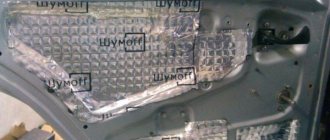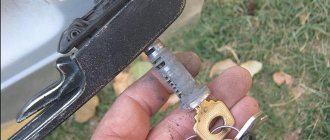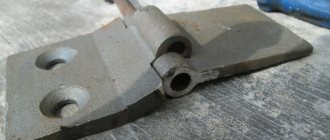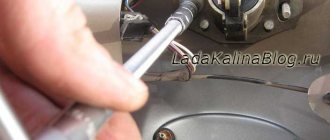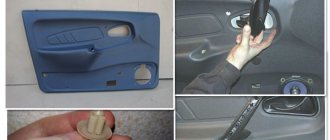How to lubricate door locks? This question plagues many car enthusiasts with the arrival of frost. The set of measures to prepare the car for winter also includes lubrication of door locks, trunk, hood, as well as lubrication of seals. For this purpose, special means are used, the purpose of which is to ensure reliable operation of locks even in severe frost conditions. In this material we will review the most popular lubricants among car enthusiasts, and also give useful tips on this matter.
Physics is not in your favor
The above problems occur due to the fact that in the cold, water turns into ice and “fetters” the lock mechanisms. It gets there either during washing, after which it is important to thoroughly blow out the openings and locks, or it accumulates on its own during operation - and at the most inopportune moment it turns out to be enough to cause problems for the motorist. The same applies to freezing door seals: you can either not get into the car or use excessive force and break the rubber bands. What to do to avoid these troubles?
They have already said about washing: it is necessary to blow through both the openings and the locks - their cylinders and the actual locking mechanisms located at the ends of the doors. Door seals and interior parts should be wiped dry and should not be left wet. If the situation is frosty, we recommend slamming the doors thoroughly half an hour to an hour after washing - this way you will “shake off” the ice that has just appeared and is not yet very strong.
Reasons for car door cylinders freezing
There are not so many reasons for freezing, but sometimes we, without even thinking, take steps towards such a problem. Common reasons:
- condensation that forms due to the temperature difference in the air and inside the car;
- a sharp decrease in air temperature after rain or wet snow;
- poor-quality drying of vehicles after a car wash;
- snow getting on the seals, which first melts under the influence of heat from the car’s interior, and then freezes;
- temperature changes from positive to negative temperatures and vice versa.
The best remedy is prevention
The risk of problems can be significantly reduced by pre-treating the parts with suitable products. And here the choice will depend on the node. So, it is better to pour a little universal lubricant into the lock cylinders - mineral oil without additives. If there is no such thing on the farm, regular motor oil will do.
But it is better to treat door hinges and locking mechanisms with a special adhesive lubricant. The fact is that these parts have friction between each other; ordinary oil does not stay on them for a long time. Therefore, it is preferable to use special products that “stick” to materials and cannot simply be removed. In this case, it is better to use lubricants with Teflon additives, which will also prevent the adhesion of dust (these are used, for example, for motorcycle chains). An important point: these products are not suitable for treating larvae, because they can simply cause the secret parts of the mechanism to stick.
You may say: why such difficulties? Isn’t it easier to use a universal product like WD40? No! Even though the “Vedeshka” has cleansing properties and displaces moisture, it cannot be considered as a protective agent, it is too “dry” and additional lubrication is needed.
Ways to protect padlocks from bad weather
The doors of modern residential premises are reliably protected from bad weather, thanks to a cornice, terrace or a special entrance canopy. But non-residential buildings often lack such extensions, and the locking devices, of course, rust, deteriorate, and freeze. Therefore, owners are wondering how to secure a padlock from rain, snow and moisture? Can:
- make a case from a plastic bottle;
- make a raincoat from a car inner tube.
Plastic bottle case
To ensure that the lock remains dry at any time and its main elements do not fail, it is necessary:
- cut off the neck of a plastic bottle;
- additionally cut off a not very wide strip from the remaining part of the bottle;
- cut the bottle lengthwise from the bottom to half. This will help to place it deeper on the body;
- put the resulting padlock cover on the latch so that the entire product is inside the bottle;
- Connect the ends from below with a plastic strip. It will serve as a fastener and will not allow the cover to come off during a strong gust of wind.
This design does not look very aesthetically pleasing, but it is an excellent protection for a padlock on a garage or any other building from adverse conditions. You also need to take care of the safety of the mechanism and find out what you can use to lubricate the padlock against rust. This is usually done with WD-40 or graphite lubricant. The main thing is that the composition is not too thick, otherwise dirt and dust will stick to it.
Useful tips! The plastic container can be replaced with a piece of polyurethane tube, securing it perpendicular to the gate.
Raincoat from a car inner tube
Another padlock protection is created with your own hands, without much expense or effort. A raincoat of the required size is cut from a sheet of rubber or an inner tube. A hole is drilled in the door above the eyelets and the cover is secured with a bolt and nut. To prevent dripping drops from penetrating under the raincoat, you can build a gasket from a sheet of steel, plexiglass, etc.
Not everyone likes this method. It looks ugly and covers the body only from the top. The flap also makes it difficult to open the lock with a key - you have to constantly support the overhanging cover with your hand.
Silicone is power! Sometimes excessive...
To prevent freezing of rubber and plastic parts (doors, windows, door handles), it is recommended to lubricate them with silicone lubricants. Which is what many motorists do, sometimes with great zeal. Meanwhile, it should be borne in mind that silicone has strong anti-adhesive properties, so getting it on the paintwork of the body is very undesirable. In the case of painting repairs, this may result in the appearance of craters where silicone molecules remain (not every solvent accepts it).
Second point: if silicone gets on the glass, an oily film will form. And if the windshield wiper blades start to smear it... In general, despite the fact that silicone lubricants are sold in spray cans, it is better not to spray them, but to apply them to a sponge and use it to treat the plastic and rubber parts that require it.
If the lock is frozen
When the lock freezes, the main thing is not to aggravate the situation by the wrong actions that first come to mind. It is strictly forbidden to:
- try to turn the key in the lock by force, risking breaking it off and damaging the structure of the lock;
- pour boiling water on the lock, as it will crack the paint on the door;
- breathe into the lock, because this will only increase the amount of moisture in it.
Also, do not resort to a very common but ineffective advice - heating the key with a lighter. In severe frost, the key will cool down even before you have time to place it in the lock. From such actions you are more likely to freeze yourself than to defrost the castle.
As an alternative to a lighter, it is better to use a specialized defroster keychain. The device is equipped with a retractable pin that must be inserted into the keyhole.
When pulled out, it automatically heats up to a temperature of about 150 degrees, and the ice in the castle melts in a matter of seconds. The key fob runs on AAA batteries, the charge of which is enough for about 10 defrosts. A similar device costs around 500 rubles.
In the absence of such a defrost, you can use improvised means by analogy. An unbent hairpin or tie clip is suitable for these purposes. Insert them into the lock with one end, and heat the other with a lighter. Just do not scorch the paintwork of the door; it is better to protect the area around the lock from fire with regular foil.
Defrosting liquids for locks, which must be poured into a frozen keyhole, are no less effective.
Preference should be given to the spray form, since such products show better performance, ridding the lock of ice within 10-15 seconds. Another advantage of defrosting liquids is their budget cost, which starts at 30 rubles.
Special products have a defrosting effect due to the presence of alcohols. Therefore, in case of emergency, you can pour any alcohol-containing liquid into the lock. Just don’t use perfume for this purpose, since the concentration of alcohol in them is too low for a defrosting effect.
Not just doors
One more note. During preventive measures, remember not only about the side doors - do not forget about the hood, trunk and gas tank flaps. And also about the neck plug, if it has a key. It’s not very pleasant to find yourself in a situation where you’re already close to the pump, but you can’t reach the plug. However, this is not the worst scenario, since at a gas station you can always find the opportunity to defrost the lock. But if you have an old Ford, where the hood can be opened with a key, there is a possibility of finding yourself in a stupid situation. Moreover, the lock behind the front emblem often freezes or even turns sour.
How to defrost?
Let's say you decide to do without prevention or it was not enough to protect the locks from freezing. What should I do? At one time, we tried a variety of methods for defrosting lock cylinders, starting with the use of special means and ending with old-fashioned methods. Their effectiveness and further consequences (what happened to the lock after some time) are clearly demonstrated by this table:
| Defrosting method | Time spent | In 30 minutes | In 60 minutes |
| Breathing | 6 minutes 37 seconds | the key cannot be inserted | |
| Exhaust gases | 5 minutes 12 seconds | the key cannot be inserted | |
| Heat the key with fire | 4 minutes 7 seconds | the key won't turn | |
| Hot water | 2 minutes 7 seconds | the key won't turn | |
| Vodka | the key cannot be inserted | ||
| Hawthorn tincture | 6 minutes 15 seconds | the key is inserted and turned | |
| Brake fluid | 4 minutes 57 seconds | the key is inserted and turned | |
| Ice defroster 1 | 5 minutes 10 seconds | The key is difficult to insert and turn | |
| Ice defroster 2 | 7 minutes 15 seconds | Everything is fine | with difficulties |
| WD40 | 15 minutes 35 seconds | with difficulties | the key won't turn |
As we can see, only after using defrosters (and also hawthorn tincture containing more than 60% alcohol) did the locks retain their functionality some time after defrosting. Traditional methods allow you to open the door (hatch), but then, in order to avoid repeated “sticking” of the mechanism, it must be treated with a moisture-displacing agent and lubricated.
What to do if it is the locking mechanism that freezes? Sometimes this happens when the door is open and the lock does not engage. This is not the worst option, because you have access to the mechanism itself, it can be treated with one or another means. Or warm up the interior thoroughly - and after some time the lock will work. True, once the author of these lines had to warm up while driving, and in order for the door to remain in the closed position, he had to fasten it to the center pillar with a seat belt...
It’s worse if the lock is frozen in the closed position and the door (trunk lid) cannot be opened, and there is no alternative access. Here you will have to warm the castle from the outside. The options may be different: use a heating pad or simply a plastic bottle filled with hot water, supply exhaust gases through a pipe, or in critical circumstances, pour hot water on the door, which is harmful to the paintwork. In any case, the effectiveness of these methods is not very high. To increase your chances, you need to heat exactly the area of the body where the locking mechanism is located.
How to keep your car from freezing in winter.
Ice is the main cause of huge problems for a car. For example, if your windshield is frozen, then you will not be able to drive your car, as it is very dangerous. But most often, drivers experience problems with ice that binds the doors, handles and locks of the car, which makes it even impossible to get inside the car. Fortunately, many of the problems associated with freezing and icing your car can be avoided. Here are tips to help you prevent your car doors and locks from freezing. You will also learn what to do if the car doors are frozen and you cannot get into the cabin.
Our verdict
Of course, there are no hopeless situations: if you can’t open the car yourself or it’s not possible to use one of the methods indicated above, you can always call specialists or, if nothing and no one helps, even load the car onto a tow truck and take it to a warm box. But we repeat: the best solution to the problem is prevention. Simply treat the locks with a suitable product and you will significantly reduce the risk of problems. And don't forget to take extra drying measures after washing. Smooth roads!
Close everything! Central locks in the Automotive Business ad database
Choosing an all-weather padlock for the street
The outdoor lock mechanism must be waterproof. It is desirable that the product itself has a rounded shape - this way water will not collect around the drainage holes. In addition, the burglary resistance will increase - placing a chisel on a sloping plane for impact is extremely inconvenient.
A waterproof padlock should have rubber O-rings on the shackle holes and a shutter or cap to protect the keyhole from the elements. In a non-freezing lock for a garage or other building, it is advisable to purchase a cylinder disk type of mechanism. It perfectly tolerates dust, dirt and moisture (in limited quantities), although it has almost zero privacy.
Also, the waterproof padlock should be made of stainless materials: brass or alloy steel. Having chosen a suitable high-quality device, do not forget that prevention and protection from snow and rain will not harm it. Then the product will last as long as possible.



